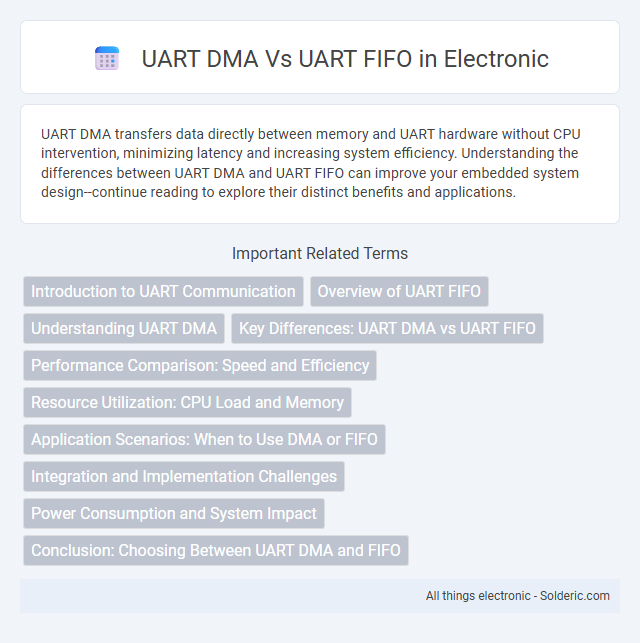UART DMA transfers data directly between memory and UART hardware without CPU intervention, minimizing latency and increasing system efficiency. Understanding the differences between UART DMA and UART FIFO can improve your embedded system design--continue reading to explore their distinct benefits and applications.
Comparison Table
| Feature | UART DMA | UART FIFO |
|---|---|---|
| Data Transfer Method | Direct Memory Access for automatic bulk transfer | Hardware buffer with fixed size for temporary storage |
| CPU Utilization | Low CPU usage due to direct data handling | Moderate CPU usage; requires frequent polling or interrupts |
| Latency | Lower latency with continuous data flow | Higher latency during buffer refill and emptying |
| Buffer Size | Memory size dependent, typically larger buffers | Typically small, fixed-size FIFO (e.g., 8-64 bytes) |
| Complexity | More complex setup and configuration | Simple and straightforward implementation |
| Error Handling | DMA controller handles data transfer errors | UART hardware signals FIFO overflow/underflow errors |
| Ideal Use Case | High-speed, continuous data streaming applications | Low to moderate speed with burst or intermittent communication |
Introduction to UART Communication
UART communication utilizes serial data transmission, where UART DMA and UART FIFO serve different roles in data handling efficiency. UART DMA offloads data transfer responsibilities directly to memory, reducing CPU involvement and enabling higher throughput for continuous data streams. Your application benefits from UART FIFO by buffering incoming and outgoing data, preventing data loss during high-speed communication bursts.
Overview of UART FIFO
UART FIFO (First-In, First-Out) is a hardware buffer used to temporarily store incoming or outgoing serial data in UART communication, enabling smoother data flow without immediate CPU intervention. It reduces CPU load by allowing multiple bytes to be queued, thus preventing data loss during high-speed transfers. FIFO depth and interrupt thresholds are key parameters that impact efficiency, with larger buffers supporting higher data throughput and more efficient interrupt handling.
Understanding UART DMA
UART DMA uses direct memory access to transfer data between UART and memory without CPU intervention, significantly reducing processor load and enhancing throughput. UART FIFO, by contrast, relies on a buffer to temporarily hold data, requiring more frequent CPU attention to manage data flow and preventing overflow. Understanding UART DMA helps you optimize embedded system performance by enabling seamless, high-speed serial communication with minimal CPU overhead.
Key Differences: UART DMA vs UART FIFO
UART DMA (Direct Memory Access) enables high-speed data transfer directly between UART and memory without CPU intervention, significantly reducing processor load and increasing efficiency in handling large data streams. UART FIFO (First-In, First-Out) buffers data temporarily within the UART hardware, allowing smoother data flow by storing incoming or outgoing bytes in sequence but relying more heavily on CPU management during data transmission. The key difference lies in UART DMA's autonomous data handling, ideal for high-throughput applications, whereas UART FIFO primarily aids in buffering and minimizing data loss at lower to moderate speeds.
Performance Comparison: Speed and Efficiency
UART DMA significantly enhances data transfer speed and efficiency by offloading data movement directly between the UART peripheral and memory, minimizing CPU intervention and reducing latency. UART FIFO relies on intermediate buffering within the UART hardware, which can introduce delays and limit throughput as the CPU must frequently handle data to prevent overflow. For your applications requiring high-speed and efficient serial communication, UART DMA offers superior performance by enabling continuous, high-volume data streams with minimal processor load.
Resource Utilization: CPU Load and Memory
UART DMA significantly reduces CPU load by offloading data transfer tasks directly between UART and memory, freeing up the processor for other operations. In contrast, UART FIFO demands more CPU cycles to manage interrupts and data handling, leading to higher CPU utilization. Your choice of UART DMA optimizes memory efficiency by enabling larger buffer sizes without frequent CPU intervention, whereas UART FIFO relies on smaller buffers with more frequent CPU access, impacting both memory and processing resources.
Application Scenarios: When to Use DMA or FIFO
UART DMA is ideal for high-speed data transmission in applications requiring efficient CPU utilization, such as real-time audio streaming or sensor data collection in embedded systems. UART FIFO suits scenarios with moderate data rates and simpler hardware, providing ease of implementation in low-power devices or basic serial communication tasks. Choosing DMA over FIFO enhances performance in systems with intensive data flows, while FIFO is preferable for cost-sensitive or less complex applications.
Integration and Implementation Challenges
UART DMA integration reduces CPU overhead by directly transferring data between UART and memory, improving data throughput, but it requires complex configuration of DMA channels and careful handling of interrupt priorities. UART FIFO implementation is simpler, relying on internal buffer management within the UART peripheral, yet it poses limitations in buffer size and latency under high data rates. Developers must address synchronization issues and memory alignment in UART DMA setups, while UART FIFO integration demands efficient polling or interrupt-driven data retrieval to avoid data overruns.
Power Consumption and System Impact
UART DMA minimizes power consumption by offloading data transfer tasks from the CPU, enabling low-power modes during communication and reducing active processor cycles compared to UART FIFO. UART FIFO relies on CPU intervention to manage data buffers, leading to higher active power usage and increased system load during data transmission and reception. Implementing UART DMA enhances overall system efficiency by lowering processing overhead and supporting extended battery life in embedded applications.
Conclusion: Choosing Between UART DMA and FIFO
Choosing between UART DMA and UART FIFO depends on your specific application requirements and system resources. UART DMA offers efficient data transfer with minimal CPU intervention, ideal for high-speed or large-volume communication, while UART FIFO provides simple buffering to handle bursts of data without complex programming. Your decision should balance performance needs, complexity, and power consumption to optimize UART communication in your embedded system.
UART DMA vs UART FIFO Infographic

 solderic.com
solderic.com